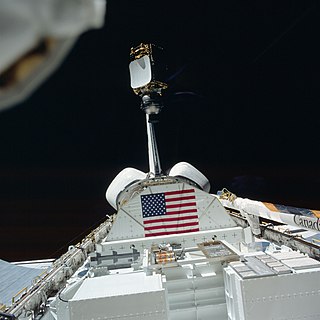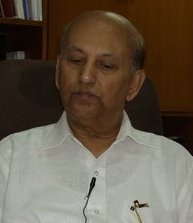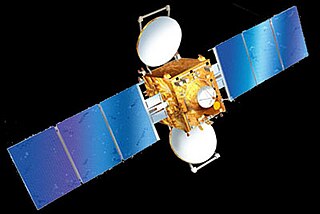Related Research Articles

STS-8 was the eighth NASA Space Shuttle mission and the third flight of the Space Shuttle Challenger. It launched on August 30, 1983, and landed on September 5, 1983, conducting the first night launch and night landing of the Space Shuttle program. It also carried the first African-American astronaut, Guion Bluford. The mission successfully achieved all of its planned research objectives, but was marred by the subsequent discovery that a solid-fuel rocket booster had almost malfunctioned catastrophically during the launch.

Daniel Charles Brandenstein is the Executive Vice President and Chief Operating Officer of United Space Alliance. He is a former Naval Aviator, test pilot and NASA astronaut, who flew four Space Shuttle missions. He also served as Chief of the Astronaut Office from 1987 to 1992.

The Indian National Satellite SystemINSAT, is a series of multipurpose geostationary satellites launched by ISRO to satisfy telecommunications, broadcasting, meteorology, and search and rescue operations. Commissioned in 1983, INSAT is the largest domestic communication system in the Indo-Pacific Region. It is a joint venture of the Department of Space, Department of Telecommunications, India Meteorological Department, All India Radio and Doordarshan. The overall coordination and management of INSAT system rests with the Secretary-level INSAT Coordination Committee.

The Indian Space Research Organisation is the national space agency of India, headquartered in Bangalore, Karnataka. It operates under the Department of Space (DOS) which is directly overseen by the Prime Minister of India, while the Chairman of ISRO acts as the executive of DOS as well. ISRO is India's primary agency for performing tasks related to space-based applications, space exploration and the development of related technologies. It is one of six government space agencies in the world which possess full launch capabilities, deploy cryogenic engines, launch extraterrestrial missions and operate large fleets of artificial satellites.

Udupi Ramachandra Rao was an Indian space scientist and former chairman of the Indian Space Research Organisation. He was also the Chairman of the Governing Council of the Physical Research Laboratory at Ahmedabad and Nehru Planetarium at Bengaluru and chancellor of the Indian Institute for Space Science and Technology (IIST) at Thiruvananthapuram. He is known as "The Satellite Man of India". He pioneered India's first satellite launch Aryabhata in 1975.
G. Madhavan Nair is an Indian space scientist and a former Chairman of the Indian Space Research Organisation, and Secretary to the Department of Space, Government of India. He has also been the Chairman of the Space Commission and Chairman of the Governing Body of the Antrix Corporation, Bangalore. He was Chairman of the Board of Governors of the Indian Institute of Technology Patna until he stepped down due to his involvement in a controversial deal relating to sale of radio spectrum bandwidth involving Antrix. He was subsequently barred from holding any private position

Indian Institute of Space Science and Technology (IIST) is a government-aided institute and deemed university for the study and research of space science, located at Valiamala, Nedumangad,Thiruvananthapuram, Kerala. It is the first university in Asia to be solely dedicated to the study and research of Outer space. It was inaugurated on 14 September 2007 by G. Madhavan Nair, the then Chairman of ISRO. IIST was set up by the Indian Space Research Organisation (ISRO) under the Department of Space, Government of India. A. P. J. Abdul Kalam, former President of India, was the Chancellor of IIST. IIST offers regular engineering undergraduate, postgraduate and doctorate programmes with focus on space science, technology and applications.

Koodli Nanjunda Ghanapathi Shankara was a space scientist from India. He was the Director of ISRO's Space Applications Centre (SAC), Ahmedabad and ISRO Satellite Centre (ISAC), Bangalore. He was the Director of Satellite Communications Program Office and Program Director, INSAT, and was looking after overall planning and direction of communication satellite program. His work in the field of transponder design and development led to a boost in India's communication satellite technology.

Koppillil Radhakrishnan is an Indian space scientist who headed the Indian Space Research Organisation (ISRO) between November 2009 and December 2014 as Chairman of Space Commission, Secretary of the Department of Space and Chairman of ISRO. Prior to this, he was the Director of Vikram Sarabhai Space Centre (2007-2009) and Director of National Remote Sensing Agency (2005-2008) of the Department of Space. He had a brief stint of five years (2000-2005) in the Ministry of Earth Sciences as Director of Indian National Centre for Ocean Information Services (INCOIS).
INSAT-3D is a meteorological, data relay and satellite aided search and rescue satellite developed by the Indian Space Research Organisation and was launched successfully on 26 July 2013 using an Ariane 5 ECA launch vehicle from French Guiana. The satellite has many new technology elements like star sensor, micro stepping Solar Array Drive Assembly (SADA) to reduce the spacecraft disturbances and Bus Management Unit (BMU) for control and telecom and telemetry function. It also incorporates new features of bi-annual rotation and Image and Mirror motion compensations for improved performance of the meteorological payloads.

INSAT 3E is a defunct communication satellite built by Indian Space Research Organisation. It was launched on September 28, 2003, from the European Space Agency's spaceport in French Guiana on board the Ariane rocket. The satellite had a launch mass of 2750 kilograms. It is the 4th satellite launched in the INSAT-3 series for INSAT. It was designed for providing high-speed communication, Television, VSAT & Tele-education services and was an important landmark in Indian Space Programme.

George Joseph is an Indian space scientist, best known for his contributions to the development of remote sensing technology in India, especially in the field of earth observation sensors. He is a former chairman of the Lunar Mission Study Task Force of the Indian Space Research Organization and an elected fellow of the National Academy of Sciences, India, Indian Academy of Sciences and Indian National Academy of Engineering. The Government of India awarded him the Padma Bhushan, the third highest civilian award, in 1999.
GSAT-10 is an Indian communication satellite which was launched by Ariane-5ECA carrier rocket in September 2012. It has 12 KU Band, 12 C Band and 6 lower extended c band transponders, and included a navigation payload to augment GAGAN capacity. Following its launch and on-orbit testing, it was placed in Geosynchronous orbit at 83.0° East, from where it will provide communication services in India.
M.Y.S. Prasad is an Indian scientist and the former director of the Satish Dhawan Space Centre Sriharikota Range (SDSC-SHAR). Govt. of India’s Civilian Award Padma Shri for the year 2014 for his distinguished service in Science and Technology.
INSAT-4B was an Indian communications satellite which forms part of the Indian National Satellite System. Launched in 2007, it was placed in geostationary orbit at a longitude of 93.48° East.

Prem Shanker Goel is an Indian space scientist, former secretary at the Department of Ocean Development, Ministry of Earth Sciences, Government of India and a former director of Indian Space Research Organization. He was honored by the Government of India, in 2001, with the fourth highest Indian civilian award of Padma Shri.
There are several ISRO facilities all over India. ISRO headquarters in Bangalore provides overall direction for the organization. There are more than twenty facilities which support ISRO.
References
- ↑ "Nair". www.astronautix.com. Archived from the original on 15 September 2016. Retrieved 30 August 2016.
- ↑ "KSCSTE Science Festival at Kanakakkunnu from Tomorrow" . Retrieved 30 August 2016.
- ↑ "Spaceline: The Challenger Legacy". www.spaceline.org. Retrieved 1 September 2016.
- ↑ "Astronauts P. Radhakrishnan and N.C. Bhat get mentally, physically prepared for space trip" . Retrieved 30 August 2016.
- ↑ "Bhat". www.astronautix.com. Archived from the original on 15 September 2016. Retrieved 30 August 2016.
- ↑ "Training for the skies". www.frontline.in. Retrieved 30 August 2016.
- ↑ Becker, Joachim. "Astronaut Biography: Radhakrishnan Nair". www.spacefacts.de. Retrieved 31 August 2016.
- ↑ "A Touch of Heroism". www.godrejappliances.com. Retrieved 1 September 2016.
- ↑ "Nair Paramaswaren Radhakrishnan". www.astronaut.ru. Retrieved 1 September 2016.
- ↑ Harvey, Brian; Smid, Henk H. F.; Pirard, Theo (30 January 2011). Emerging Space Powers: The New Space Programs of Asia, the Middle East and South-America. Springer Science & Business Media. ISBN 9781441908742.